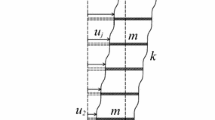Abstract
In the framework of seismic design of structures, response spectrum analysis (RSA) is the most commonly used approach in practice. The most popular combination rule is the complete quadratic combination (CQC) which is also prescribed by the most of seismic design codes and is based on the assumptions that the seismic acceleration is a white noise process and the peak factor ratios associated to the total and modal responses are unitary. Recently, the damping adjusted combination (DAC) rule has been developed for base-isolated structures to overcome the aforementioned simplified assumptions. Although it has been proved that the simplifications about peak factors lead to noticeable errors in the case of base-isolated structures, the accuracy gain of DAC with respect to CQC in the case of fixed-base structures is still unknown. Therefore, the paper presents an in-depth study on the RSA of three-dimensional frame structures, aimed to evaluate the accuracy of the above methods. Two reference classes of frame structures having different degree of complexity are considered. Average interstorey drift and floor torsion responses, obtained from a set of Time History Analyses are compared with those of the modal combination rules. Lognormal joint probability density functions of the predictive errors from CQC and DAC are finally evaluated for a reliability assessment of the two combination rules under bidirectional seismic excitations.
























Similar content being viewed by others
References
Basone F, Cavaleri L, Muscolino G, Di Trapani F (2017) Incremental dynamic based fragility assessment of reinforced concrete structures: stationary versus non-stationary artificial ground motions. Soil Dyn Earthq Eng 103:105–117
Birely AC, Lowes L, Lehman D (2012) A model for the practical nonlinear analysis of reinforced-concrete frames including joint flexibility. Eng Struct 130:455–465
Cacciola P (2010) A stochastic approach for generating spectrum compatible fully nonstationary earthquakes. Comput Struct 88(15–16):889–901
Cacciola P, Colajanni P, Muscolino G (2004) Combination of modal responses consistent with seismic input representation. J Struct Eng (ASCE) 130(1):47–55
Carvalho G, Bento R, Bhatt C (2013) Nonlinear static and dynamics analyses of reinforced concrete buildings-comparison of different modelling approaches. Earthq Struct 4(5):451–470
Castaldo P, Palazzo B, Della Vecchia P (2015) Seismic reliability of base-isolated structures with friction pendulum bearings. Eng Struct 95:80–93
Castaldo P, Palazzo B, Della Vecchia P (2016) Life cycle-cost and seismic reliability analysis of 3D systems equipped with FPS for different isolation degrees. Eng Struct 125:349–363
Castaldo P, Ferrentino T, Palazzo B (2017) Seismic reliability-based ductility demand evaluation for inelastic base-isolated structures with friction pendulum devices. Earthq Eng Struct Dyn 46(8):1245–1266
Cavaleri L, Di Trapani F, Macaluso G, Papia M (2012) Reliability of code proposed models for assessment of masonry elastic moduli. Ing Sismica 29(1):38–59
Cavaleri L, Di Trapani F, Asteris PG, Sarhosis V (2017) Influence of column shear failure on pushover based assessment of masonry infilled reinforced concrete framed structures: a case study. Soil Dyn Earthq Eng 100:98–112
CEN, European Committee for Standardisation. Eurocode 8: design provisions for earthquake resistance of structures, part 1.1: general rules, seismic actions and rules for buildings, prEN 1998-1; 2003
CS.LL.PP. DM 14 Gennaio, Norme tecniche per le costruzioni. Gazzetta Ufficiale della Repubblica Italiana; 2008
Der Kiureghian A (1980) Structural response to stationary excitation. J Eng Mech Div 106(6):1195–1213
Der Kiureghian A (1981) A response spectrum method for random vibration analysis of MDF systems. Earthq Eng Struct Dyn 9(5):419–435
Der Kiureghian A, Nakamura Y (1993) CQC modal combination rule for high-frequency modes. Earthq Eng Struct Dyn 22(11):943–956
Fajfar P (2000) A nonlinear analysis method for performance-based seismic design. Earthq Spectra 16:573–592
Falsone G, Muscolino G (1999) Cross-correlation coefficients and modal combination rules for non-classically damped systems. Earthq Eng Struct Dyn 28(12):1669–1684
Lin YY, Chang KC (2003) A study on damping reduction factor for buildings under earthquake ground motions. J Struct Eng (ASCE) 129(2):206–214
Lin YY, Miranda E, Chang KC (2005) Evaluation of damping reduction factors for estimating elastic response of structures with high damping. Earthq Eng Struct Dyn 34(11):1427–1443
Menun C, Reyes JC, Chopra AK (2015) Errors caused by peak factor assumptions in response spectrum based analyses. Earthq Eng Struct Dyn 44(11):1729–1746
Muscolino G, Palmeri A, Versaci C (2013) Damping-adjusted combination rule for the response spectrum analysis of base-isolated buildings. Earthq Eng Struct Dyn 42(2):163–182
Palmeri A (2006) Correlation coefficients for structures with viscoelastic dampers. Eng Struct 28(8):1197–1208
Penzien J (1997) Evaluation of building separation distance required to prevent pounding during strong earthquakes. Earthq Eng Struct Dyn 26(8):849–858
Rosenblueth E (1951) A basis for aseismic design. Ph.D. thesis. University of Illinois: Urbana, IL
Rosenblueth E, Elorduy J (1961) Responses of linear systems to certain transient disturbances. In: Proceedings of the 4th world conference on earthquake engineering, Santiago, Chile
Shinozuka M, Sato Y (1967) Simulation of nonstationary random process. J Eng Mech 93(1):11–40
Vanmarcke EH (1975) On the distribution of the first-passage time for normal stationary random processes. J Appl Mech 42(1):215–220
Villaverde R (1988) Rosenblueth’s modal combination rule for systems with non-classical damping. Earthq Eng Struct Dyn 16(3):931–942
Wilson EL, Der Kiureghian A, Bayo EP (1981) A replacement for the SRSS method for seismic analysis. Earthq Eng Struct Dyn 9(2):187–192
Author information
Authors and Affiliations
Corresponding author
Additional information
Publisher's Note
Springer Nature remains neutral with regard to jurisdictional claims in published maps and institutional affiliations.
Rights and permissions
About this article
Cite this article
Basone, F., Castaldo, P., Cavaleri, L. et al. Response spectrum analysis of frame structures: reliability-based comparison between complete quadratic combination and damping-adjusted combination. Bull Earthquake Eng 17, 2687–2713 (2019). https://doi.org/10.1007/s10518-019-00559-7
Received:
Accepted:
Published:
Issue Date:
DOI: https://doi.org/10.1007/s10518-019-00559-7




